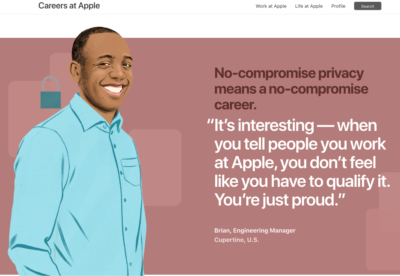
In today’s talent marketplace, employee branding is essential. Top talent has more opportunities than ever to find a company that fits their needs, and they want to work for companies that care about them, not just as workers but as people.
Employee branding isn’t just a nice-to-have; it’s essential for companies of all sizes. Over half of US employers report that their companies focus more on employee branding than they did five years ago. And these employers see results: 75% report an increase in revenue, and 50% report an increase in profitability from employee branding initiatives.
What is Employee Branding?
If you’ve been in the business world for a while, you’ve probably heard of employer branding. But what about employee branding? A new term in the human resource field, employee branding, is how a company develops an image of its employees and aligns it with its employer brand.
Employee branding is an internal and external marketing strategy that encourages employees to develop positive attitudes about their company, empowering them to be more effective brand ambassadors. The goal is to get every employee excited about being part of your organization.
In summary:
- Employee branding is the practice of creating a meaningful, engaging experience for your organization’s internal stakeholders.
- Employer branding is different because it focuses on how a company markets itself to potential hires rather than presenting its current employees to the world.
Why is Employee Branding Important?
Employee branding is essential because it creates a consistent message about your company and its culture.
We all know the world has changed drastically in the last few years when we saw the Great Resignation, where over 5 million employees left their jobs to start their own businesses. Gen Z is officially the largest generation in the United States, and they’re not inclined to stick around at a job they don’t feel positively about.
Employee branding is essential because it attracts the right talent to your company. In today’s world, people are looking for more than just a paycheck—they want to work for companies with values that align with their own.
A 2021 FlexJobs survey of 4,600 workers suggests that almost 70% of people would consider changing their careers to find a job that offers more work-life balance.
Employee branding is also important because it ensures that your employees are happy, engaged, and loyal. Keeping employees happy will limit insider threats regarding data security due to disgruntled employees.
When you focus on showing a cohesive brand picture to both customers and employees, both groups will come to know what you stand for and be inspired.
The Benefits of Employee Branding
Employee branding is a marketing strategy that focuses on achieving business goals by building and communicating your employer’s brand. It’s all about connecting with employees, helping them build a professional identity, and developing their careers.
Here are just a few benefits of building a strong employee brand:
Attract the best talent
Recruiting great people is the hardest part of growing a business for many companies. Employee branding helps you stand out from other employers in your industry, making it easier to find the right people for your team.

Mos is an excellent example of a company using employee branding, an ambitious mission, and content to create a truly modern-age bank. Focusing on students in a system that can be uphill in most cases, they offer solutions for teenage bank accounts, student debt, scholarships, grants, and more.
Building an attractive brand requires identifying your company’s unique value proposition (UVP) and communicating it effectively to potential employees. You should also promote your company culture, talk about your achievements, and define what you’re looking for in new employees.
Retain your best employees
People are the best asset for any company, especially those who have been around for a while and know how everything works. They take years of experience when they leave, which can be challenging to replace.
Companies with small teams trying to build something revolutionary and innovative have to create an employee culture that will promote their brand. Stack not only does this by offering great benefits, but they also want their employees to share their vision of creating something that will change millions of users’ lives.

Employee branding helps you build loyalty among long-term employees by providing them with opportunities for personal growth, offering incentives for their performance, and engaging them through various feedback channels.
Gain more customers
By aligning the brand with employee needs and goals, you can create a culture with intrinsically motivated employees to work well and spread positive word-of-mouth about your company.
Employee branding can help you attract more customers, investors, and business partners. When employees are happy and feel like they’re making a real difference at work, they’re more likely to become brand advocates.
This type of public praise for your company helps build a good reputation for your brand. And when you have an excellent reputation with potential customers and investors, everyone wins.
How to Build Your Employee Brand
A strong employee brand helps your company attract top talent and retain current employees. The best employee brands built on trust and transparency convey what it’s like to work at your company through your employees’ eyes.
Here are a few steps to help you build a powerful employee brand:
Identify your company’s core values
If you don’t already have them, develop a set of core values that define your organization’s culture and identity. These should extend beyond just being profit-driven or customer-obsessed. For example, “We foster innovation” or “We thrive in a collaborative environment.”
Define the company culture
To develop a great employee brand, you need to be able to define what makes you unique as an employer. This includes defining your company values, mission and vision statements, and overall workplace culture.
There are many layers to company culture, everything from your branding materials to how you speak to your employees and customers. For instance, utilizing fun vector graphics in internal newsletters can demonstrate that your workplace is lighthearted and creative. Ditching strictly business lingo in exchange for a more conversational tone on Slack and email can promote a more relaxed and enjoyable company atmosphere.
Identify your target employee
In order to attract the best fit talent for your company, you need to know who you want to hire and what skills they have so you can create a strategy that will appeal to them.
Put yourself in the shoes of your ideal candidate: What do they look for in a job? What are their career goals? Do they like to work on their own or as a team?
Once you have figured out what type of employee you want, you can then tailor your marketing message to that type of person.
Map the employee journey
It’s important to understand the employee journey, from sales and recruitment to training and performance management.
Once you’ve mapped out this journey, you can accurately identify where your strengths and weaknesses lie. You might find one area of your business is performing exceptionally well, or you might discover that a new technology or process will be required.
Get your employees involved
Employee referrals account for more than 45% of internal hires. Encourage your employees to spread the word about your company, and you’ll be able to cast a wider net in your recruitment efforts.
5 Tips to Build Effective Employee Branding Strategies
1. Link your employee brand to your employer brand
Employer branding is a worthwhile marketing channel, particularly when there is a tight job market and talent shortages.
If your company is an exceptional place to work, candidates will choose to apply at your company over one that might not have as much to offer. When people are happy, they are productive, and when you employ the right ones, your business will grow and thrive.

2. Focus on your current employees
According to a recent study, only 30% of businesses use employee branding to boost retention, which is surprising because a single lost employee can cost an organization 50% to 60% of their annual salary.
That’s why it is crucial to focus on keeping your current employees satisfied, given it is more expensive to hire a new employee than it is to retain your existing ones.

3. Make use of your social media
Starbucks has a job seeker account—@starbucksjobs—where the company shows its appreciation for current employees and interacts with future ones.
If your employees are on board with your employee branding strategy, ask them to share their daily work life photos. This way, people outside of your company or interested in working for you will be able to discover what’s going on backstage.

4. Don’t forget about your company culture
Create an environment in which people are excited to work and where they’ll naturally have good things to say about it.
Consider Google’s “20 percent time” policy, allowing employees to spend 20 percent of their working hours on creative side projects. That’s a concrete example of a culture that breeds innovation, pride, and loyalty.

5. Be consistent
Consistency is key to building an effective employee brand. Regardless if you are circulating content internally or externally, your message should be cohesive, consistent, and aligned with your company culture and values.
Apple does an excellent job aligning its employee branding with its core values, especially regarding privacy. They state the following on their privacy page: “Privacy is a fundamental human right. At Apple, it’s also one of our core values. Your devices are important to so many parts of your life. What you share from those experiences, and who you share it with, should be up to you. We design Apple products to protect your privacy and give you control over your information. It’s not always easy. But that’s the kind of innovation we believe in.”
Brian, an Engineering Manager at Apple, shares a similar message on the Apple Career page. He is particularly proud of his work that helps Apple protect customers’ privacy.

As you can see, Apple’s messaging is consistent. They practice what they preach, which in turn builds trust and strengthens employee branding.
Does Your Company Have a Strong Employee Brand?
Knowledge is power, and knowing what you’re already doing well—and where you can improve—is the first step to making an effective employee branding campaign. Use these three tips as a starting point for knowing your company’s reputation among current employees.
1. Put yourself in your employees’ shoes
It might sound basic, but it’s easy to forget that your employees aren’t going to have the same perspective as you. They don’t have the same history with the company, and they might not understand how the organization works. If you want to get a clearer idea of your company’s reputation among its staff, try taking on a different role or position than what you usually do.
2. Survey your team
When you create a survey and ask your team members to fill it out, you need to make sure they’re honest. Don’t tie participation in the survey to reward or punishment. Otherwise, people may give you biased answers that aren’t reflective of their opinions. Let them know their feedback will be kept confidential, and thank them for their participation afterward.
3. Understand key metrics
To know how you’re doing with your employee branding, you should monitor these essential metrics:
- Employee retention rate
- Referral rate from current employees
- Employee satisfaction rates during onboarding and after one year on the job
Conclusion
Employee branding is marketing your company to employees, similar to how you’d sell to customers. It’s a strategy that helps you attract and retain the best talent, boost employee satisfaction, and increase productivity.
Overall, it’s a powerful tool for promoting a positive workplace culture, building a desirable employer brand, and encouraging employees to feel proud of their work. And it can help you improve your company’s reputation in the eyes of job seekers by showing off your organization’s best qualities.
 Guillaume is a digital marketer focused on handling the outreach strategy at uSERP and content management at Wordable. Outside of work, he enjoys his expat life in sunny Mexico, reading books, wandering around and catching the latest shows on TV.
Guillaume is a digital marketer focused on handling the outreach strategy at uSERP and content management at Wordable. Outside of work, he enjoys his expat life in sunny Mexico, reading books, wandering around and catching the latest shows on TV.